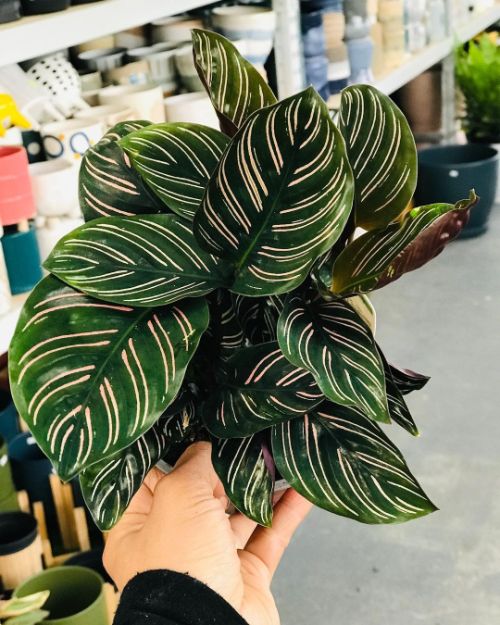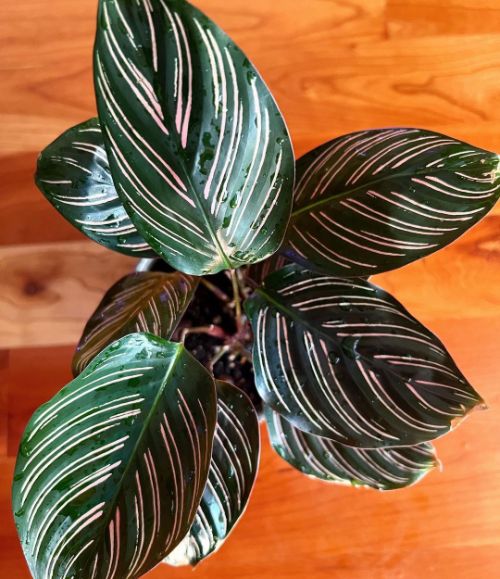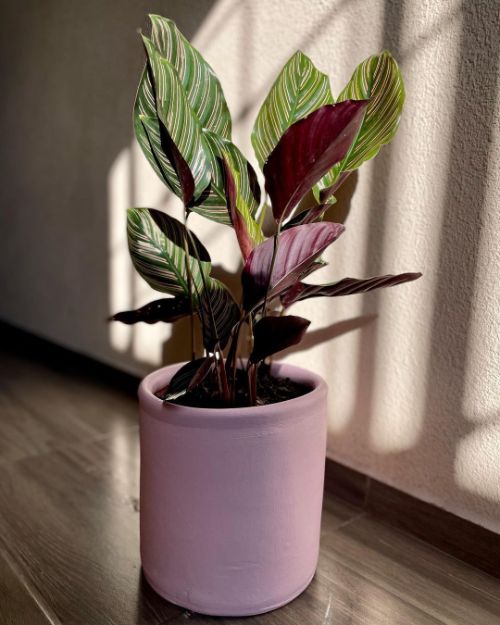Looking for a cool and pretty easy houseplant? The Calathea Ornata could be the perfect pick for you. To keep it alive and kicking, like with any other plant, you gotta know how to look after it. We’re gonna tell you all you need to know about Calathea Ornata care in this post, including tips on soil, lighting, watering, and more. These care tips will help keep your Calathea Ornata happy, whether you’re a plant pro or just getting started.
Calathea Ornata: What Is It?
- Pretty leafy Calathea ornata, also known as Pinstripe Plant or Pinstripe Calathea, is part of the prayer plant family (Marantaceae).
- Prayer plants’ leaves fold up and point upward at night and chill during the day, just like other plants in the same family.
- Naturally tropical, Calathea ornata, is known as the “pinstripe plant” for its funky color bands.
- Indoor-grown calathea ornata plants often rock green leaves with cool violet undersides.
- Originally from the West Indies, South America, Central America, Thailand, and Africa, it is loved for its oval, bright, colorful leaves. These plants are ace for growing in an indoor pot because they typically grow tall and wide to around two feet each.
- Calathea is a gorgeous indoor plant that cleans the air while catching your attention, boosting both the look of your home and your overall well-being.

Calathea Ornata Care Quick Overview
| Scientific Name | Goeppertia Ornata |
| Common Name | Calathea Ornata, Calathea Pinstripe, Pinstripe Plant |
| Light | Likes bright but not direct light |
| Watering | Water weekly if the top inch of soil is dry |
| Temperature | 65 to 85ºF (18 to 29ºC) |
| Hardiness Zone | 10 to 11 |
| Humidity | 50 to 80% |
| Soil Type | Prefers loamy, moist but well-draining |
| Soil pH | 6.5 (mildly acidic) |
| Fertilizing | Feed once a month in spring and summer |
| Repotting | Repot every couple of years |
| Pruning | Prune when needed to remove damage |
| Propagation | Division |
| Toxicity | Safe for humans and pets |
| Mature Size | Grows 24 to 36 inches indoors |
| Bloom Time | Don’t expect blooms indoors |
Calathea ornata care tips
We’re gonna chat about the best soil to use, how much light is needed, how and when to feed it, humidity, typical pests, and early signs your plant is having trouble.
If you’ve had a tough time with this plant before, this guide’s for you. We’ll look at various parts of looking after a Calathea in the tutorial below:
Ideal Water
All Calatheas love a bit of humidity, not only the Ornata. An essential bit of keeping your plant in good shape is carefully watching soil moisture and water quality.
Water this guy before it gets too thirsty because it doesn’t appreciate completely dry soil. Depending on how dry the soil is, you gotta water this plant either once per week or twice every two weeks during the summer and can water this plant every two to three weeks over the winter.
Your plant will be super happy if you keep the soil pretty evenly moist. Your Calathea ornata will have loads of, not-so-pretty, crispy brown tips and edges on the foliage if you often let your soil totally dry out.
At the same time, don’t let these plants sit in water for too long. Always empty the saucer of any extra water. Or, if your plant is in a nursery pot and has been placed in a decorative pot without a drainage hole, be sure to check for any water collection and chuck it. Leaving your plant in water for a long time will raise the chances of the dreaded root rot.
Calatheas are famous for being choosy and sensitive to fluoride in tap water, and over time they often get crispy, brown leaves.
You can use tap water no problem, but if you’ve spotted brown edges and wanna step up your Calathea game, try using distilled or RO water for a bit and keep an eye on the new growth.
Don’t water your plant with cold water. Water should be lukewarm or at room temp. Rainwater is a great choice for your green buddies if you don’t live in an area that is highly polluted.
You gotta watch the new foliage over time to see the real effect because once leaf edges go brown, they will stay that way.
To sum up the watering:
- This plant likes its soil always moist.
- Don’t let this plant sit in a puddle.
Humidity
The tropical dude, Calathea Ornata, loves places with high humidity levels. For the plant to keep its vibrant leaves and stop the leaves from drying up and getting crispy, the humidity level’s gotta be at least 60%.
There are a few simple stuff you can do to make the area around your Calathea Ornata more humid, like:
- Put a water tray near the plant, or use a humidifier to add moisture to the air.
- Give the plant’s leaves a regular mist with room temperature water.
- Get your Calathea Ornata to hang out with other plants to make a tiny greenhouse vibe.
- Use a pebble tray, fill it up with pebbles and water, then place your plant on top of the pebbles.
If you keep the ideal humidity level, your Calathea Ornata will thrive and it will also show off its gorgeous leaves.
Ideal light
Bright to medium indirect light is perfect for Calathea ornata plants. They like strong, filtered light and nothing too direct because direct sunlight might hurt the leaves by burning them. If you put it near a north or east-facing window, your Calathea Ornata can get a lot of bright yet indirect light.
If your home doesn’t get enough natural light, you can add artificial light. To give your Calathea Ornata the light it needs to grow and do well, a grow light or a fluorescent light can be a fantastic option. To avoid burning the leaves, keep the light source a fair distance away from the plant.
Remember, too much light can make the leaves on your Calathea Ornata curl or get brown edges. On the other hand, if the plant gets too little light, the leaves may turn pale and sag. To keep your Calathea Ornata doing great and vibrant, you gotta find the right balance of light.
Discover the Key to Healthy Calathea: Unveiling the Secrets of Calathea Light Requirements!
Required temperature
Calathea ornata plants are all for not so direct light that’s bright to medium. They’re into strong, filtered light, but not too much straight sunlight because it might hurt the leaves by scorching them. Your Calathea Ornata will be doing great if you put it near a north or east-facing window, where it can catch plenty of bright but not so direct light.
If your place doesn’t get enough natural light, no worries, just add some fake light. A grow light or a fluorescent light can be a fantastic alternative to give your Calathea Ornata the light it needs to grow and do well. Keep the light source a nice distance away from the plant to avoid scorching the leaves.
Keep in mind, too much light might make the green guys on your Calathea Ornata curl or get brown edges. On the other hand, if the plant isn’t getting enough light, the green guys may turn pale and droop. So, to keep your Calathea Ornata doing great and vibrant, you gotta find the perfect light balance.
Fertilizer requirements
For your Calathea Ornata to stay in shape and look its best, it needs feed pretty often. The warm months are the best time to feed because that’s when the plant is actively growing. So, feed your Calathea Ornata around every three to four weeks.
No need to feed a lot in winter. That’s because the Calathea plant naturally hits a growth dip as winter rolls around. Too much feed when a plant’s chillin’ out can kinda hurt it. So, when feeding, go for balanced feed to make it grow.
If you feed your Calathea too much, the roots might burn, which would gradually kill the plant. So, follow the instructions that come with your liquid feed. When you use liquid feed, it’s much easier to keep track of the amount, which helps to avoid overfeeding your Calathea.
It’s a good idea to water with diluted feed, using the suggested 1/4 teaspoon per gallon of water each time. It’s advised to feed with this mix after every water.
Every now and then, water with pure distilled water to flush out any build-up of salts in the soil that could be causing the brown leaf tips on Calatheas, which can be sensitive to built-up feed salts in the soil.
Soil mix
While all Calathea plants need soil that drains well, they also like soil that holds water. The perfect soil acidity, if you’re keeping track, is 6.5 (slightly acidic). So, it’s a good idea to find soil that holds a lot of water. Because this plant can stay in damp soil for a long time, you won’t need to water as often. If your soil isn’t great at holding onto water, no worries. Just water the plant more often to keep the soil moist.
If your soil gets really tight and heavy, you might want to choose a different soil. This kind of soil won’t let any air get to the roots and the plant will gradually choke.
You can try these examples of soil mixes, for instance:
- Three parts of a good all-rounder mix, like Espoma organic, plus one part of pumice or perlite. The cool thing about pumice over perlite is that it doesn’t rise to the top.
- Peat to sand in a mix of three is a great blend. (Coarse sand is the best kind.).
- For this, soil with bigger chunks and/or moss will work well because it holds water and lets air get through.
- Remember to use pots that have holes for draining.
Insect
Even though Calathea ornata is pretty sturdy, it can sometimes fall victim to bugs or illnesses just like other houseplants do.
The most common buggers and diseases that mess with this plant are scale, spider mites, mealybugs, and aphids, along with stuff caused by bacteria and fungus growth.
One big problem bug you gotta keep an eye out for with your calathea plant is spider mites. These little red spiders suck on the sap of leaves, which can eventually shrivel up and drop off. Your plant might die because of this.
Here are some things you should know for dodging pests and insects:
- Bugs can be dodged by keeping an eye on moisture and airflow.
- If you spot any signs of damage or the mites themselves, give your plants’ leaves a quick blast with a garden hose or your shower head.
- Neem oil, a natural bug killer that offs mites when they touch it, can also be slathered on the plant’s leaves.
- Keeping things more humid can push away spider mites. Dry air is like a party for spider mite growth. Just don’t let it get too humid.
- You can give your plant a little lukewarm water rinse once a week in your shower or sink. This is a handy thing you can do to control and avoid spider mites.
Pruning Calathea Ornata
Your calathea plant might sometimes have brown leaves. No biggie! This just means that it’s time to trim your plant and is totally normal. Just take off the leaves as they show up using your fingers or a small set of pruning shears to do this.
Keeping a healthy growth pattern and the plant’s overall height will be easier by getting rid of the dead growth.
You might find it good to sometimes dust your calathea plant. Just use a clean, damp cloth to wipe away any dust from the leaves before spraying them to make sure the humidity gets spread evenly. After dusting and cleaning it down, you should remove any last-remaining yellow calathea leaves to give your plant more energy and a little refresh.
Propagation
Unlike many other plants, Calathea Ornata can’t be propagated by taking cuttings. You gotta split your Calathea as soon as it starts to make a new plant from its roots.
If new stems are popping out of the soil away from any existing stems, your Calathea Ornata has made a new plant in the same pot. This is different from new leaves on the same plant cause they grow from stems that are already there. Plus, your plant can make new stems, which always pop up from the ground next to any existing stems. Stems from the same plant will often grow into a clump.
Splitting the plant is the most handy way to propagate, and it’s best done during the active growing season. This is easiest to do when there’s time for a bigger pot and time to repot. Your plant will eventually form a clump with additional plants growing in the same pot.
- Yank the plant from its pot and carefully pry it apart into as many separate plants as you’d like at the roots.
- If the roots are all tightly tangled, use a pair of clean, sharp pruning scissors to separate individual plants. Just make sure each clump still has some roots attached.
- Make sure the plant gets regular spritzes and watering so that its roots can grow strong and healthy.
- To make this whole thing easier, water your plant the day before.
Common problems & questions of Calathea Ornata
Why Are Calathea Ornata’s Leaves Turning Yellow?
Lower leaf turning yellow is a common thing, and as long as the new growth is strong and healthy, there’s no reason to freak out.
Some of the causes of yellow leaves are:
Super wet or dry soil, root sickness, water that’s harsh, chlorinated, or has fluoride, not enough humidity, too cold or hot temps, and other stuff stressing the plant can also make leaves drop and turn yellow.
Why are the stripes and leaves on my Calathea ornata becoming pale?
Not enough light might make the leaves go paler and start to lose their characteristic stripes.
Why isn’t the growth of my Calathea ornata?
Light is the most crucial thing for growth. Move your plant to a brighter spot if it’s in a darker area far from a window. Of course, you’ll still need to watch things like temperature and proper watering.
The Calathea ornata is an awesome addition to any indoor or outdoor space cause of its easy care requirements and lovely foliage.
If you follow my steps, you’re better set to take care of it. At the very least, these steps will show you how to see signs and fix them to keep your Calathea healthy and help it grow.
The most important things to remember with this lovely plant are:
- Make sure it gets loads of indirect sunlight and water regularly.
- Give your plant a balanced fertilizer every two-three weeks during the spring and summer.
- Keep an eye out for mealybugs, spider mites, and aphids, and treat them with an OKed bug or fungus killer as soon as you can.
I hope this FamiPlants post will help you keep your plants healthy and looking good! If you need more info on a particular plant, you can always ask for some help with a plant. Thanks for reading!
Learn more about Other Calathea care resources:




